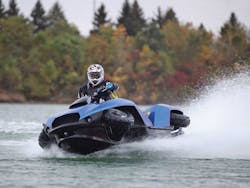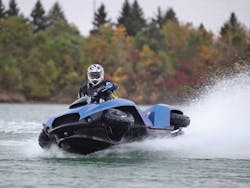Navy to develop unmanned amphibious vehicle for sea, surf, and land operations
ARLINGTON, Va. - U.S. Navy researchers are asking industry to develop an amphibious unmanned vehicle able to swim through the ocean and move over land to evaluate coastal areas as invasion beaches, special forces maneuvers, or other military operations.
The unmanned amphibious vehicles must be able to swim through the ocean from at least two miles offshore, negotiate ocean swells and surf safely, and overcome obstacles such as mud flats, rocks, urban development, and vegetation such as mangroves. The idea is to develop an unmanned vehicle able to conduct surveillance and reconnaissance, clear mines, and secure terrain to enable follow-on forces such as Marines and Special Forces to move ashore safely.
Officials of the Office of Naval Research (ONR) in Arlington, Va., issued a solicitation (N00014-17-S-B004) for Autonomy and Unmanned Vehicle Technologies to Support Amphibious Operations. This initiative seeks to capitalize on technologies of unmanned underwater vehicles (UUVs), unmanned surface vessels (USVs), and unmanned ground vehicles (UGVs). Such technologies include domain-agnostic machine autonomy, sensors, robotics, and kinematics.
By blending these technologies, ONR experts hope to develop autonomous amphibians able to maneuver individually and collectively through the surf zone and emerge to navigate ashore, and then return to the sea after collecting important information.
These unmanned amphibious vehicles must be able to maneuver, sense, and communicate autonomously in the challenging sea-land interface in varied shore environments. These vehicles would take part in the first wave into contested landing zones.
The Autonomy and Unmanned Vehicle Technologies to Support Amphibious Operations program has two technology thrusts: shallow-water and land autonomy for vehicles to operate independently and in teams, and vehicle prototypes for test and evaluation.
Technology area 1 centers on autonomy and manned-unmanned teaming, including sensing, perception, navigation, coordination, and decision-making necessary for amphibious vehicles to swim through the ocean, negotiate the surf zone, and operate on land individually and in teams. This includes swell and breaking wave measurement, dynamic object segmentation and tracking, terrain classification, and methods for mitigating adverse environments, including fog, rain, dust, and salt spray.
Participating companies will use a Gibbs Quadski from Gibbs Sports Amphibians in Nuneaton, England, to demonstrate unmanned amphibian technologies. The four-year program will award contracts worth $250,000 and $4 million per year.
Companies interested should e-mail white papers to [email protected]. Send full proposals no later than 31 March 2017 to the Office of Naval Research, Attn: Troy Hendricks, ONR Department Code: 30, 875 North Randolph Street - Suite 645, Arlington, VA 22203-1995.
E-mail questions to [email protected]; [email protected]; or [email protected].
More information is online at http://bit.ly/2jgy9h5.

